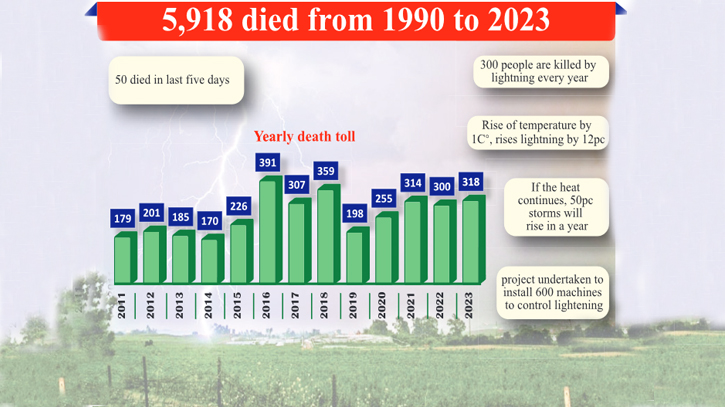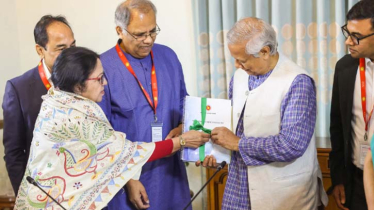
Photo: Messenger
In a tragic turn of events, lightning has emerged as one of the deadliest natural disasters in the country, surpassing the toll from floods and cyclones. Over the past five days, approximately 50 individuals have tragically perished due to lightning strikes across various regions of the country.
United Nations data reveals that Bangladesh witnesses an average of 300 lightning-related fatalities annually. Remarkably, in the United States, a nation 61 times larger than Bangladesh, the annual lightning-related death toll stands at less than 20 individuals.
Thunderstorms occur more frequently during the monsoon season. During this time, people in farmlands, open fields, playgrounds, or open wilderness are victims of lightning. However, in recent times, many deaths due to lightning have occurred outside the monsoon season. Along with that, the extent of lightning-prone areas is also increasing.
Experts say climate change is being blamed for the excess lightning. The rate at which deforestation and carbon emissions are increasing is adversely affecting the atmosphere. As a result, the surrounding weather is creating a favorable environment for lightning.
According to the Department of Disaster Management, the Haor and North-Western regions of the country are generally identified as lightning-prone areas. Recently, lightning has been increasing in other districts as well. Disaster and climate experts said that the temperature is increasing due to climate change. Due to this, most disasters are increasing. It can increase up to 12-25 percent depending on location. Among these disasters, rainfall with thunder is the most common.
According to experts, the weather in the country is at its hottest before the monsoon, i.e., from March to May. Due to excess temperature, a lot of water vapor is formed at this time. This water vapor acts as the main force of lightning. The more water vapor, the more thunderclouds form, and the more frequent the thunderstorms.
Professor Dr. Md Zillur Rahman, Chairman of Dhaka University's Disaster Science and Climate Resilience Department, told The Daily Messenger, "A study by the United States has shown that an increase in temperature by 1 degree Celsius will increase lightning by 12 percent. It is the same everywhere. The temperature increased by 1 degree Celsius from 2010-2024."
He also said that the temperature in the southern and hilly regions of the country was not the same as it is now. The temperature rose. As a result, lightning also increased. In places where lightning is already high, there will be more now. And in areas where there was less, there will be an increase. If this temperature continues, there will be 50 percent more thunderstorms in a year.
According to the data of the Department of Disaster Management, the death rate due to lightning has increased in Bangladesh in the last seven years due to climate change. Last year, 318 people died due to lightning in 56 districts. More than 50 were injured. About 300 people died in the previous year as well. Besides, 179 people died in 2011, 201 people in 2012, 185 people in 2013, 170 people in 2014, 226 people in 2015, 391 people in 2016, 307 people in 2017, 359 people in 2018, 198 people in 2019, 255 people in 2020, and 314 people died in 2021.
Besides, 16 districts of the country witnessed more lightning strikes and deaths. The list includes Sylhet, Sunamganj, Habiganj, Kishoreganj, Netrokona, Sirajganj, Mymensingh, Dinajpur, Pabna, Naogaon, Bogra, Chapainawabganj, Rajshahi, Jamalpur, Gaibandha, and Tangail.
However, in the last two years, the number of deaths due to lightning has increased in coastal and mountainous areas, including the southern part of the country. These include Jashore, Barisal, Patuakhali, Cox's Bazar, Shariatpur, Rangamati, Satkhira, Brahmanbaria, Narsingdi, Cumilla, Khulna, Kushtia, Chattogram, and Khagrachari.
Meanwhile, the government declared lightning as a disaster in 2016. According to an estimate, 2,142 people died due to lightning in the country from 2015 to 2022, and 538 people were injured during this period. According to an estimate by the Ministry of Disaster Management and Relief, the number of people killed by lightning is known at different times. However, it is not known precisely how many people are injured by lightning, how many cattle are killed, or how many trees are destroyed.
According to another estimate, 5,600 people died due to lightning in the country from 1990 to 2022. According to the research paper titled 'Lightning Fatalities in Bangladesh from 1990 through 2016' published in the Journal of the American Meteorological Society, the maximum number of people died in Bangladesh due to morning and afternoon lightning.
Nitai Chandra Dey Sarkar, Director (Monitoring and Information Management Division) of the Department of Disaster Management, told The Daily Messenger, "For the last two years, there has been an anomaly in the weather. The effects of El Niño are visible. During the winter, the winter was not too cold. El Niño will be followed by La Niña effects. It is feared that the number of lightning strikes will increase this year."
He also said, "Lightning can be seen in about 50 districts in the country. In those districts where lightning was less, it is now happening more. It's not always more intense in one place. Earlier, it used to be more in Faridpur, now it is getting less. Thunderstorms used to be sporadic in the mountains, now there are more. The reason for this may be that there has been an increase in temperature."
"While the number of lightning deaths in the country is known, the number of lightning strikes is not known because of technical limitations. However, 360 lightning arresters have been installed in 15 districts so far, through which it is known when and where lightning strikes. We are undertaking another project where there are plans to install 600 machines," he added.
Meanwhile, there was a severe heatwave across the country throughout the month of April this year. People's lives became unbearable due to the continuous heat wave. However, the rains of the last few days have brought some relief in public life. Although the rain is accompanied by a lot of hail and lightning. Thunderstorms occur even during short periods of rain. The rate of lightning and hail is higher in this rain than in normal times.
In this regard, Bazlur Rashid, the meteorologist of the Bangladesh Meteorological Department, told The Daily Messenger that black clouds are formed when it rains after a prolonged heat wave. These clouds are higher than the ground. Hail falls from such clouds. The higher the cloud, the larger the hailstone. Again, if the height of the cloud increases, the thunder is louder, and the lightning is also more frequent.
Warning everyone about lightning, this meteorologist said, "If there are dark clouds in the sky, and if rain falls from these clouds, one should not go out to get wet. Because now there is a risk of lightning. Therefore, if you are outside during the rain, you should take shelter in a safe place. You cannot go to the roof of the building. If possible, lightning rods should be installed indoors and in buildings."
Messenger/Disha








